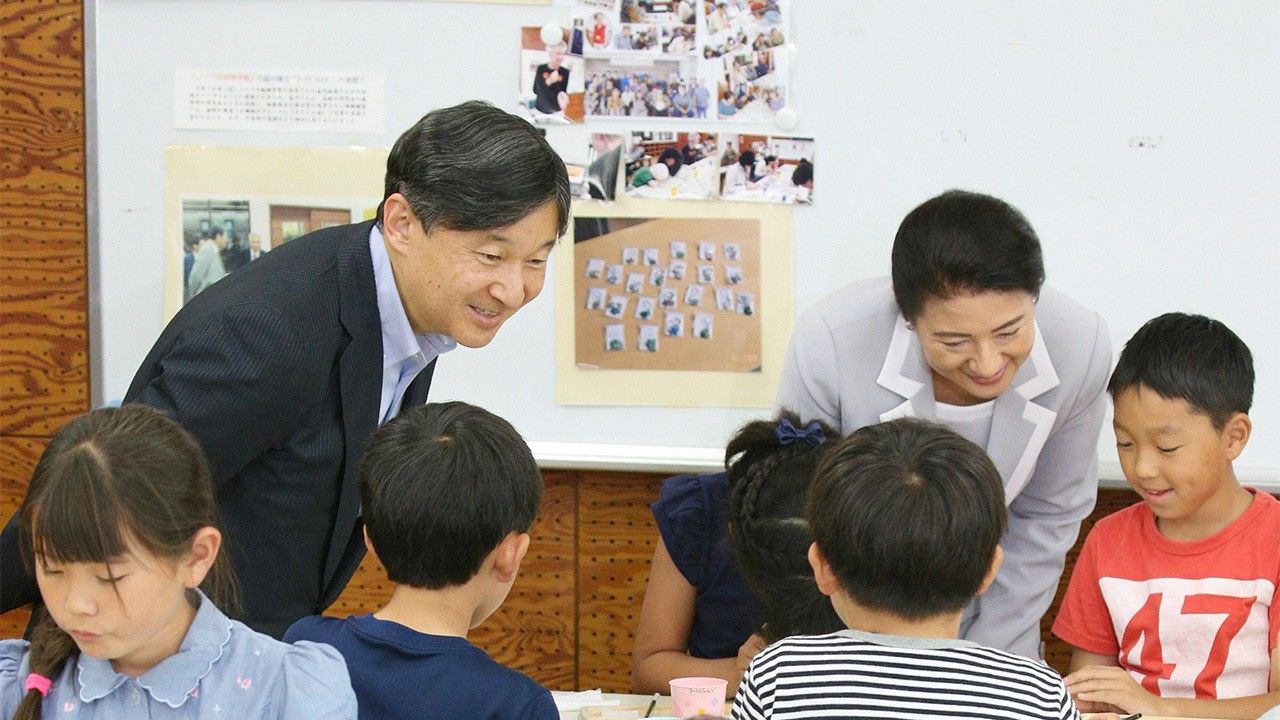
The Emperor as a Symbol: The Meaning of the Unity of the People Has Evolved with Time
Society Imperial Family- English
- 日本語
- 简体字
- 繁體字
- Français
- Español
- العربية
- Русский
The Delicate Position of the “Emperor as Symbol”
Many people thought that the Olympics should be canceled this year due to the COVID-19 pandemic. Some of these people wanted the emperor, who was Honorary Patron of the Olympic and Paralympic Games Tokyo 2020, to voice his opposition. In his “symbolic” position, however, the emperor did not have the authority to make a statement on what could be considered a political matter. Therefore, Nishimura Yasuhiko, grand steward of the Imperial Household Agency, made an announcement that the emperor was worried by the increase in the number of infections and his thoughts were with the people, hinting at the emperor’s concerns. This shows the delicate balance upon which sits the existence of the emperor.
In the 1889 Meiji Constitution, the prewar supreme law of the Empire of Japan, the notions of an imperial line “unbroken for ages eternal” and an emperor whose sovereignty was based on and wielded in accordance with the constitution coexisted, so that the emperor’s position rested on a fine balance. Domestically, a line of reasoning came into play that used the emperor as a symbol of power to overthrow the shogunate, while on the global stage, he was presented as a presence that would rule Japan in line with the rule on law, as per the norms of international society. Both of these notions were needed in order for the Meiji state to function. In prewar Japan, these two notions were both brought into play in a variety of ways, with one outweighing the other depending on the period.
In the early years of the twentieth century, Japan saw the rise of a mass-consumption society, with rapid urbanization and a growing presence for newspapers, magazines, and other media. European notions of democracy also started to creep in, sparking moves to build a political system that placed weight on the will of the people; a cabinet system that excluded the will of the emperor as much as possible was put in place. The media also sought and reported on an imperial system that was in tune with the trend toward democracy. During these years the notion of an emperor in line with constitutional principles was gaining weight. But with the Shōwa era (1926–89) came opposition to this notion, and the view of the emperor as an instrument of power became predominant, eventually leading to war.
A Postwar Chance for Change
After Japan’s defeat in 1945, it looked like the imperial system of early modern Japan would be overhauled. There were growing calls from the Allied powers to place responsibility for the war on the emperor, and the continuation of the imperial system was in jeopardy. The General Headquarters of the Allied Forces, however, viewed the matter differently. GHQ aimed to follow a process of democratization in which Japan would not oppose the Allies in the future and, based on US studies of the situation in Japan begun well before the end of the war, judged it vital to leave the imperial system in place in order to carry out the Occupation successfully.
However, leaving things as they had been in Japan would not satisfy public opinion in the Allied countries. This is what led GHQ to stress the democratization of the emperor system, such as with the “declaration of humanity” by Emperor Hirohito (posthumously Emperor Shōwa). The final form of the emperor resulting from this was his position as “symbol of the State” as spelled out in the postwar Constitution of Japan. By legally limiting the duties of the emperor to ceremonial functions, they were able to depict the postwar imperial system to the world as something different.
The Japanese side was keen on maintaining an imperial system close to that of the beginning of the twentieth century, even after defeat. In the end, though, they had no choice but to accept the GHQ proposal, and the emperor became a “symbol.” The nature of this symbolism was very vague, though; depending on its interpretation, it seemed to the Japanese, it might also be brought closer to the direction that they had in mind. One could say that the postwar imperial system has been formed in the process of defining this direction.
One aspect of this was Emperor Hirohito’s visits around the country undertaken in the postwar years. Article 4 of the Constitution states, “The Emperor shall perform only such acts in matters of state as are provided for in this Constitution,” and there was no mention in the document of imperial tours. Nowadays, these trips are interpreted as “acts in matters of state” rooted in his position as a symbol. GHQ believed that the democratization inherent in such tours, where the emperor would meet the people, would appeal to the global community. At the same time, it saw these trips as necessary to bring comfort to people who were devastated following defeat in the war.
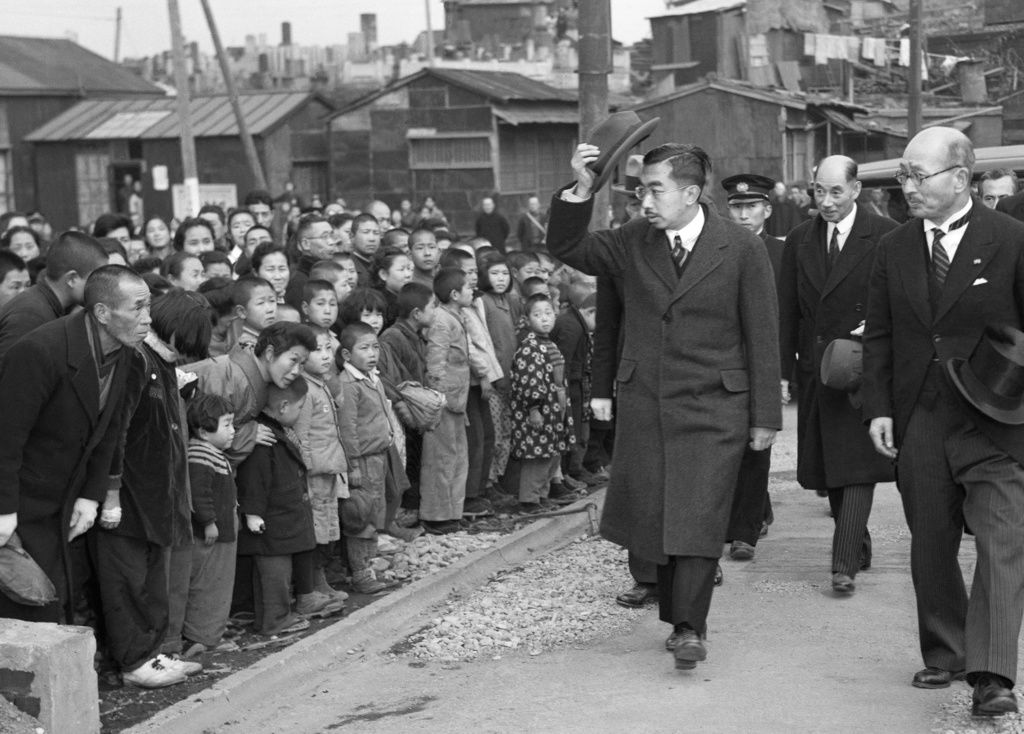
The tours around Japan started in February 1946. Here Emperor Hirohito is seen here visiting people living in Yokohama. (© Kyōdō)
In fact, GHQ recognized the authority of the emperor and sought to make use of it. The Japanese side shared this opinion. With both sides on the same wavelength, the tours by the emperor got under way. Among the Japanese populace, those who had been educated before the war perceived these tours as authoritarian in nature; the media, however, threw itself behind highlighting the positive changes in the imperial system, so that many people welcomed this new version. While the tours were in fact implemented to boost the power and authority of the emperor, they ended up viewed more as postwar changes in the direction of democracy. As one would expect, a number of inconsistencies arose from these differing perceptions.
Searching for a New Symbolic Role
The process of defining the symbolic emperor in the modern Japanese context remained ongoing, and the way this symbol was popularly perceived also continued to shift with the times. Crown Prince Akihito’s debut on the official stage as a young man in the 1950s coincided with the “new beginning” associated with the 1951 signing of the peace treaty between the Allied powers and Japan. The image of the crown prince was not associated with the war, and he was presented by the media as a fresh youth, leading to ever greater public expectations of him.
Akihito’s engagement to Shōda Michiko was announced in 1958, triggering a “Mitchī boom” the next year. There had been expectations of marriage with a member of the wider imperial family, and people were taken by surprise by this engagement to an “ordinary citizen.” Added to that the rumor that this was a marriage of love, based on mutual consent as specified in the Constitution, made people feel ever closer to the system of the emperor—and now the crown prince—as a symbol. The media, already in a frenzy over the high economic growth, published and broadcast countless stories about the couple. At that time, new media were appearing, with the founding of women’s weekly magazines and the diffusion of television sets in people’s homes, all of which fueled the boom.
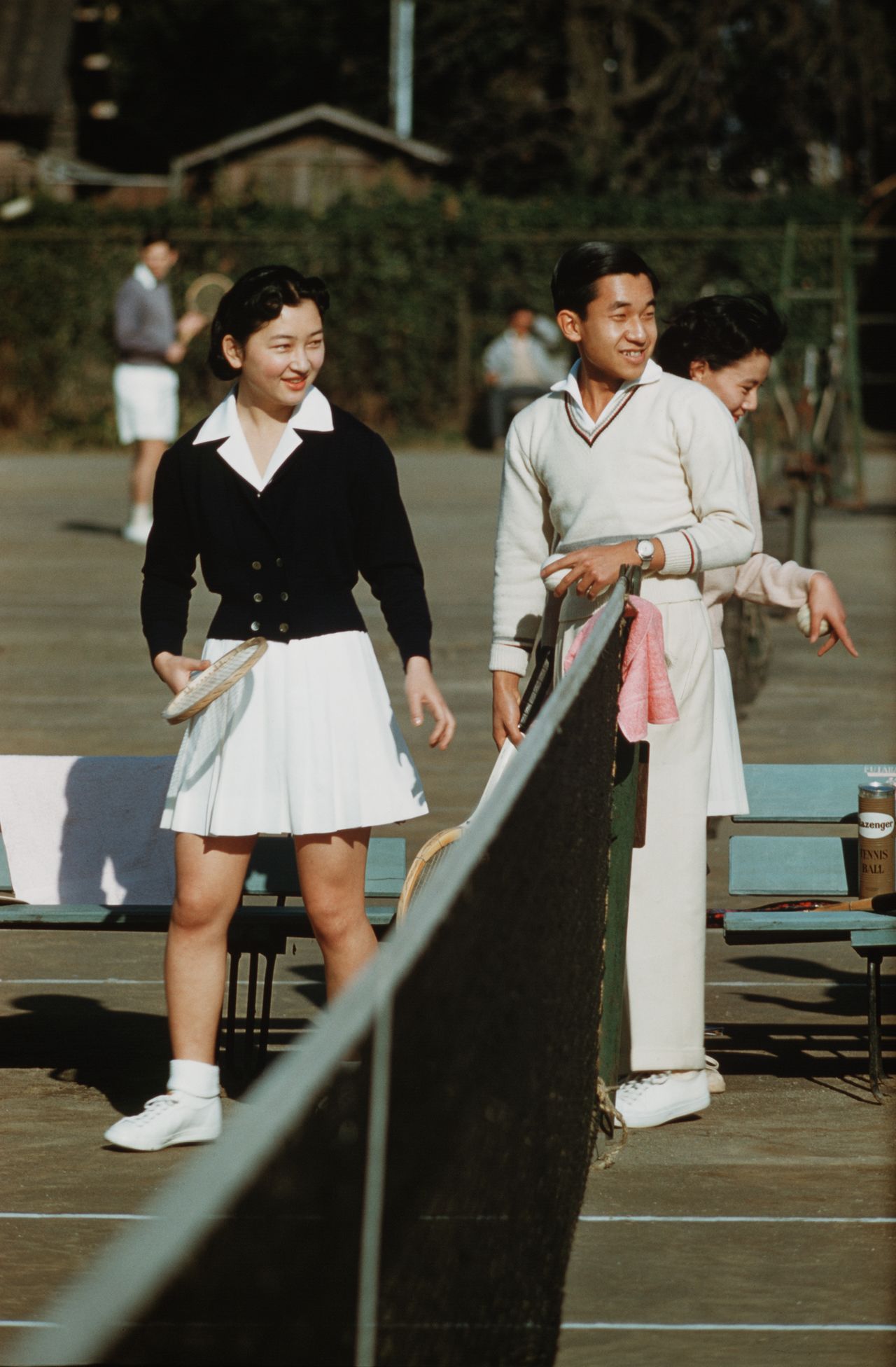
Crown Prince Akihito and Shōda Michiko enjoying a game of tennis at the Tokyo Lawn Tennis Club on December 6, 1958. (© Jiji)
At the time, the government was aiming to broaden the interpretation of the emperor as symbol, bringing him closer to an official head of state. In the end, however, it proved impossible to convince people to call the emperor a head of state rather than a symbol for Japan. As the “Mitchī boom” had made clear, the emperor as a symbolic presence had become firmly embedded since the war and turned into an ideal by those who had experienced democracy; the idea of nonauthoritarian emperor had gained broad acceptance. The media’s influence in bringing this about had been considerable.
However, as Crown Prince Akihito and Princess Michiko played their popular new parts following their 1959 wedding, they were also doubtless rather perplexed. In reality, that kind of frenzied boom tends to cool down with the passing of time. This is why the young couple looked for the best way to remain meaningful symbols going forward. Since there were no regulations prescribing the role of a crown prince or princess in the Constitution of Japan or the Imperial Household Law, they had to think of something themselves.
What they came up with was involvement with socially vulnerable people. They started to visit welfare facilities and actively connected with the people there. On the occasion of their overseas visits on behalf of Emperor Hirohito, they engaged in commemorations of World War II. Through their ongoing efforts they built the blocks for the future evolution of the role of the emperor as a symbol. By combining European-style constitutional sovereignty and a traditional Japanese-style imperial system, the crown prince created the impression that the role of the emperor should be “to share the people’s joys and sorrows.” And he believed that the symbolic nature of the emperor made him an ideal figure to do just this.
Building Today on the “Heisei Style“
From the second half of the 1960s onward, though, the media paid less attention to Akihito’s and Michiko’s efforts in this area. Through their long years as crown prince and princess, the media and the people of Japan seemed to tire somewhat of the emperor system itself. As the economy boomed and people focused on their own lives, appreciation of the emperor as a symbol waned.
Akihito’s enthronement in 1989 changed this, bringing a fresh wave of interest in the symbolism of the emperor. After they became emperor and empress, they continued to explore the appropriate actions to take in their role, and their war memorial trips remained a part of their itinerary. This was picked up by the media, who dubbed it the “Heisei style” of imperial comportment; their actions and opinions made a vivid impression on people. As the generation who had actually experienced the war faded away, their image as figures touching thoughtfully on memories of World War II were welcomed by many people as the ideal manifestation of the emperor as a symbol.
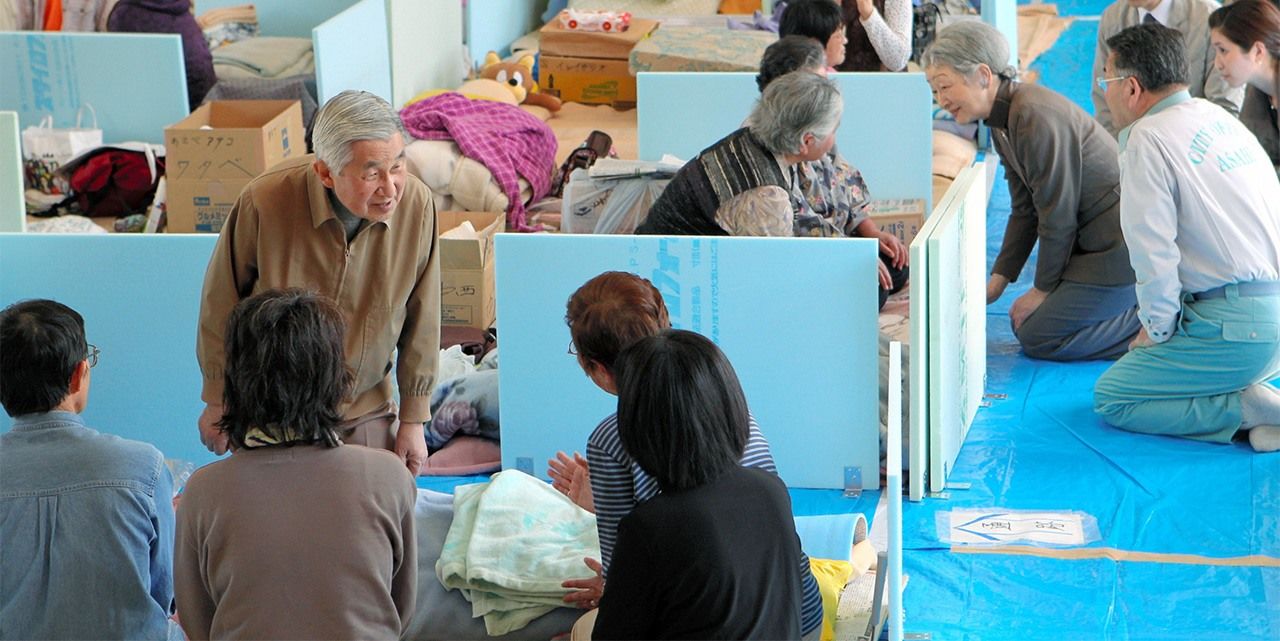
Emperor Akihito and Empress Michiko chat with evacuees at the Asahi City Health Center in Chiba Prefecture on April 14, 2011, following the Great East Japan Earthquake. (© Jiji)
The Heisei era (1989–2019) also saw a number of powerful natural disasters. The emperor and empress, who had continued their involvement with vulnerable people, were very active in visiting disaster victims as an extension of this. They continued their visits to welfare facilities and took an interest in those alienated from society, especially those who could be called vulnerable. Putting into practice the concept of “sharing the people’s joys and sorrows” became part of the “Heisei style.” And the emperor’s travels were seen very differently from those of his father, Emperor Shōwa, as he visibly thought of the people and came to share in their hardships. This is an image that has been passed down into the Reiwa era, which began with Naruhito’s accession to the throne in 2019.
Today, the emperor’s pronouncements and various actions in the face of the COVID-19 pandemic could be called an extension of the “Heisei style.” The statement mentioned at the beginning hinted at consideration for those who were opposed to the Olympic Games, and concern at the rise in infection numbers. On the other hand, there were many people involved in the preparations for the games, and Emperor Naruhito also showed consideration for them as he fulfilled his role as honorary patron, speaking at the opening ceremony. Within the current fragmentations in Japanese society, the emperor can be said to be taking his own initiative to act as a symbol to unite the people.
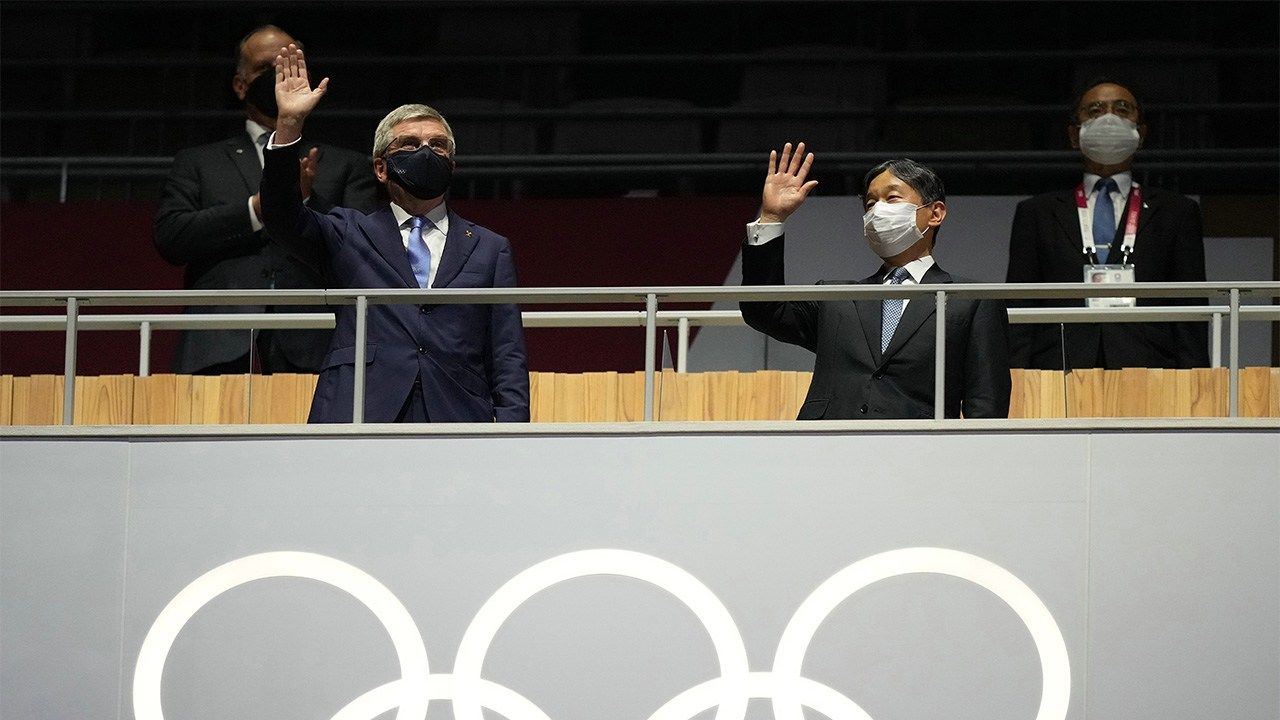
Emperor Naruhito, at right, waving at the opening ceremony of the Olympic Games alongside Thomas Bach, president of the International Olympic Committee, on July 23, 2021. (© Jiji)
(Originally published in Japanese. Banner photo: Emperor Naruhito and Empress Masako visit elementary schoolchildren at an experimental classroom of the Shippō Art Village in the city of Ama, Aichi Prefecture, on June 1, 2019. © Jiji.)